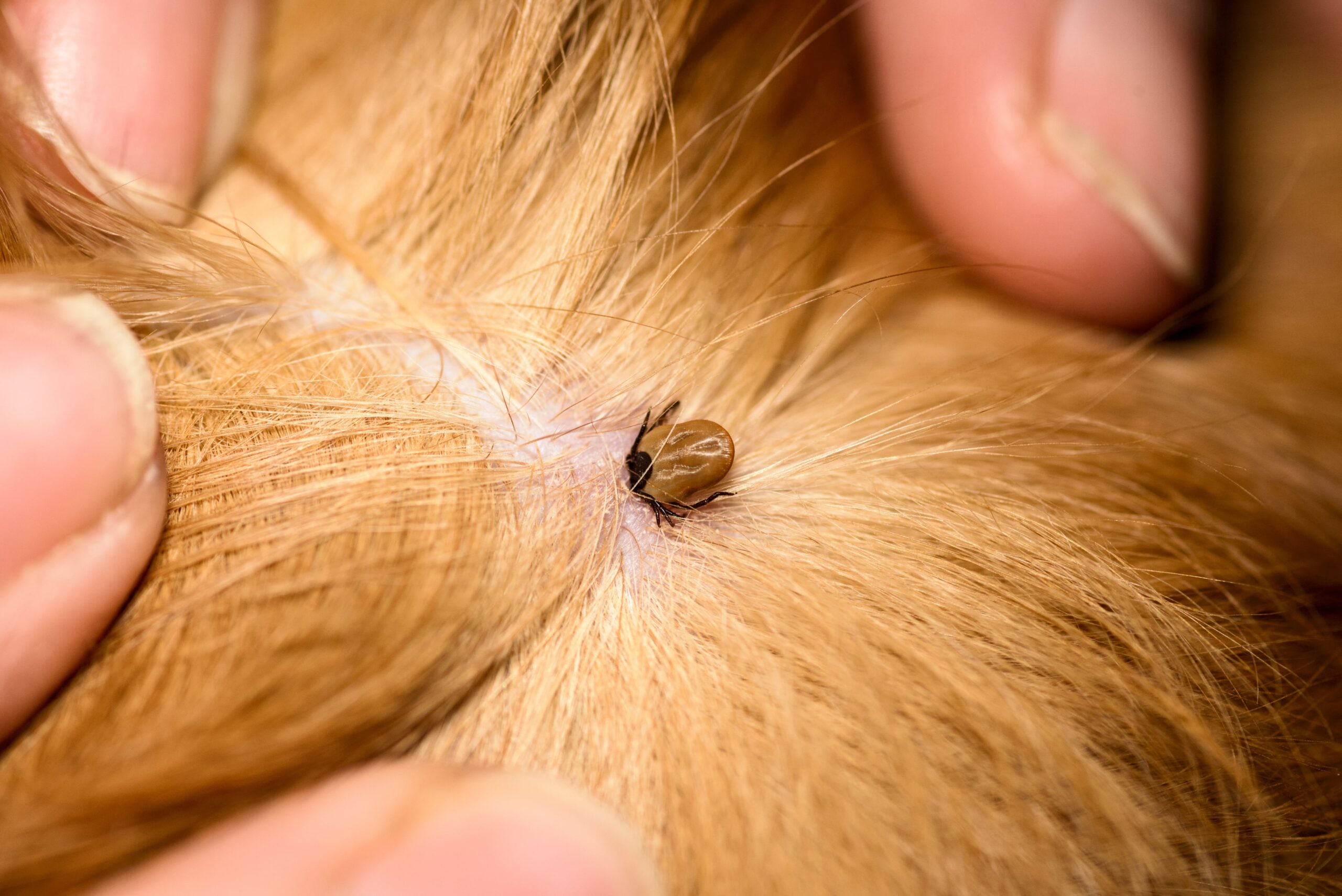As spring begins to bloom and the weather warms, pet owners eagerly welcome the longer days and outdoor adventures with their furry companions. Recently, I took Harley, my 7-year-old Golden Retriever for his annual check-up at the veterinarian’s office. It was time to renew his monthly prescription for heartworm prevention. Previously, I had been administering Sentinel to both Harley and Sasha as their heartworm preventative, but during our visit, our new veterinarian, Dr. Reyes, recommended a different option: Simparica Trio.
Dr. Reyes outlined the advantages of Simparica Trio over Sentinel, underscoring its effectiveness against fleas, ticks, and internal worms. She stressed the importance of tailoring preventive medication to our pets’ specific parasite protection needs. Simparica Trio offers a comprehensive defense against fleas and ticks, while also safeguarding against internal worms. Notably, Simparica Trio swiftly eliminates existing fleas within 3 hours and ticks within 8 hours after administration, providing rapid relief. Conversely, Sentinel suits dogs prone to whipworms and in need of flea protection. It’s important to note that while Simparica Trio acts promptly to remove existing parasites, Sentinel disrupts the flea life cycle preventatively rather than directly targeting existing pests.
Dr. Reyes advised that pet owners with pregnant, lactating, or breeding dogs should opt for the safest option, which is Sentinel. It is essential to consider your pet’s individual needs and prioritize the parasite protection that is most important to you and your furry friend.
Because it is the season to be mindful with prevention, let’s delve into the importance of heartworm and Lyme disease prevention in spring and the proactive measures pet owners can take to safeguard their pets’ health during this season of outdoor exploration.
The Link Between Prevention and Disease
Heartworm disease and Lyme disease are both serious health concerns for dogs, but they have one crucial aspect in common: prevention. Both diseases are primarily preventable through proactive measures, emphasizing the significance of preventive care in keeping our pets healthy and happy.
Heartworm Prevention
Heartworm disease, transmitted through the bite of infected mosquitoes, can lead to severe and sometimes fatal complications if left untreated. However, with the availability of effective preventatives, such as monthly medications and annual testing, pet owners can significantly reduce the risk of heartworm infection in their furry companions. By staying consistent with preventive measures and working closely with their veterinarians, pet owners can shield their pets from this silent but deadly disease.
Lyme Disease Prevention
Lyme disease, caused by the bacterium Borrelia burgdorferi and transmitted through the bite of infected ticks, poses a significant threat to dogs, particularly in regions where ticks are prevalent. While vaccination against Lyme disease is available, prevention remains the cornerstone of protection. Regular tick checks, tick preventatives, and environmental management strategies can help minimize the risk of tick exposure and subsequent Lyme disease transmission. By adopting these preventive measures, pet owners can take proactive steps to safeguard their pets from the dangers of Lyme disease.
As pet owners, it is our responsibility to prioritize our pets’ health and well-being year-round, but especially during the spring months when the risk of heartworm and Lyme disease transmission is heightened. By understanding the correlation between prevention and disease and taking proactive measures to protect our furry companions, we can ensure they enjoy a safe and healthy spring season filled with outdoor adventures and cherished memories.
Through regular veterinary care, diligent parasite prevention, and ongoing education, we can empower ourselves to be proactive advocates for our pets’ health and provide them with the protection they deserve against heartworm and Lyme disease. Let’s make this spring a season of health and happiness for our beloved pets.
Where Ticks Thrive
- Lyme disease-carrying ticks thrive in environments such as tall grasses, thick brush, marshes, and wooded areas. These locations serve as ideal hiding spots for ticks, allowing them to wait for passing dogs. Once a tick attaches to a dog, it takes between 24 to 48 hours for the tick to transmit the disease.
- Initially identified in Lyme, Connecticut, in 1975, this disease poses detection challenges and can lead to severe and persistent health issues in both canines and humans.
- Although Lyme disease occurs nationwide, the risk of infection varies across regions. The Northeast, Upper Midwest, and Pacific Coast account for over 95% of cases, with fluctuating rates influenced by factors like deforestation, deer migration, and bird populations.
- While rare, Lyme disease cases emerge annually on the West Coast, particularly in Northern California. In Canada, infected dogs are primarily found in southern Ontario and southern Manitoba, with fewer instances reported in southern Quebec and the Maritime Provinces.
How Dogs are Tested for Lyme Disease
- Lyme disease diagnosis involves a comprehensive approach, including reviewing medical history, assessing physical symptoms, and conducting diagnostic tests. Veterinarians administer two primary blood tests: the C6 Test and Quant C6 test.
- The C6 test identifies antibodies targeting the “C6” protein, indicating an active Lyme infection. Antibodies can manifest within three to five weeks post-tick bite, even before visible symptoms emerge.
- Following a positive C6 test, a Quant C6 test, combined with urinalysis, helps gauge the necessity for antibiotic treatment.
Treating Lyme Disease in Dogs
- Antibiotics constitute the primary treatment for Lyme disease, typically administered for a minimum of 30 days. While symptoms often subside swiftly, persistent infections may require prolonged medication. Additional therapies aim to alleviate specific symptoms.
Lyme Disease Transmission and Prevention
- Dogs do not directly transmit Lyme disease to humans; transmission solely occurs through tick bites. However, ticks carried by dogs can pose a risk if they latch onto humans.
- If your dog contracts Lyme disease, assess the potential exposure risk for other pets and family members who shared the outdoor environment. Consulting both a physician and veterinarian is advisable for guidance on testing and preventive measures.
- Regular tick checks for both dogs and humans are crucial, particularly after outdoor activities. Inspect key areas like feet, toes, lips, eyes, ears, anus, and tail for ticks.
- Prompt tick removal reduces the risk of secondary illnesses. Familiarize yourself with proper removal techniques and invest in quality tick removal tools.
- During veterinary exams, request thorough tick checks to ensure no ticks are overlooked.
- Employ veterinarian-recommended flea and tick products to shield your dog from tick infestations.
- Maintain short grass and minimize exposure to grassy areas, particularly in tick-prone regions.
- Consider vaccinating your dog against Lyme disease after discussing suitability with your veterinarian, as some dogs may not require vaccination.
In conclusion, prioritizing the health and well-being of our furry companions is crucial for responsible pet owners, particularly during the heightened risks of heartworm and Lyme disease transmission in spring. By understanding the significance of preventive measures, we can take proactive steps to safeguard our pets. Through regular veterinary care, diligent parasite prevention, and ongoing education, we empower ourselves as proactive advocates for our pets’ health. Let’s ensure this spring becomes a season of health and happiness for our beloved pets by implementing preventive measures and remaining vigilant against heartworm and Lyme disease.
Q & A
Q: What are the symptoms of heartworm in dogs?
A: Symptoms of heartworm in dogs may include coughing, difficulty breathing, fatigue, decreased appetite, and weight loss.
Q: Can heartworm be treated in dogs?
A: Yes, heartworm in dogs can be treated, but it requires a comprehensive treatment plan supervised by a veterinarian. Treatment typically involves a series of medications and strict rest.
Q: Do dogs usually survive heartworm treatment?
A: With proper veterinary care, the majority of dogs can survive heartworm treatment. However, treatment can be lengthy and may have risks, particularly for severe cases.
Q: What are the risks of heartworm infection in dogs?
A: Heartworm infection in dogs can lead to severe and potentially fatal complications, including heart failure, organ damage, and respiratory issues.
Q: How can I prevent heartworm in my dog?
A: Preventative measures for heartworm in dogs include administering monthly heartworm preventatives prescribed by a veterinarian, minimizing exposure to mosquitoes, and annual heartworm testing.
Q: What are the symptoms of a dog with Lyme disease?
A: Dogs with Lyme disease may exhibit a range of symptoms, including fever, lethargy, lameness, joint swelling, decreased appetite, and swollen lymph nodes. In some cases, dogs may also experience kidney dysfunction, neurological issues, and heart abnormalities.
Q: Can Lyme disease be cured in dogs?
A: While Lyme disease in dogs can be treated with antibiotics, it is important to note that the infection cannot be completely cured. Treatment aims to alleviate symptoms, eliminate bacteria, and prevent the progression of the disease. However, dogs may remain carriers of the Lyme disease-causing bacteria even after treatment.
Q: Do dogs usually survive Lyme disease?
A: With prompt diagnosis and appropriate treatment, most dogs affected by Lyme disease can recover and lead normal, healthy lives. However, the prognosis may vary depending on the severity of the infection, the presence of complications, and the timely administration of treatment.
Q: What are the 3 stages of Lyme disease?
A: Lyme disease in dogs typically progresses through three stages:
Early Stage: In the early stage of Lyme disease, dogs may exhibit mild symptoms such as fever, lethargy, and lameness. This stage occurs within the first few weeks to months following exposure to the Lyme disease-causing bacteria.
Acute Stage: During the acute stage, dogs may develop more pronounced symptoms, including joint swelling, shifting lameness, and decreased appetite. Kidney dysfunction and neurological issues may also manifest during this stage.
Chronic Stage: In the chronic stage of Lyme disease, dogs may experience persistent symptoms and complications, such as recurrent lameness, kidney damage, and heart abnormalities. Chronic Lyme disease can lead to long-term health issues if left untreated.




